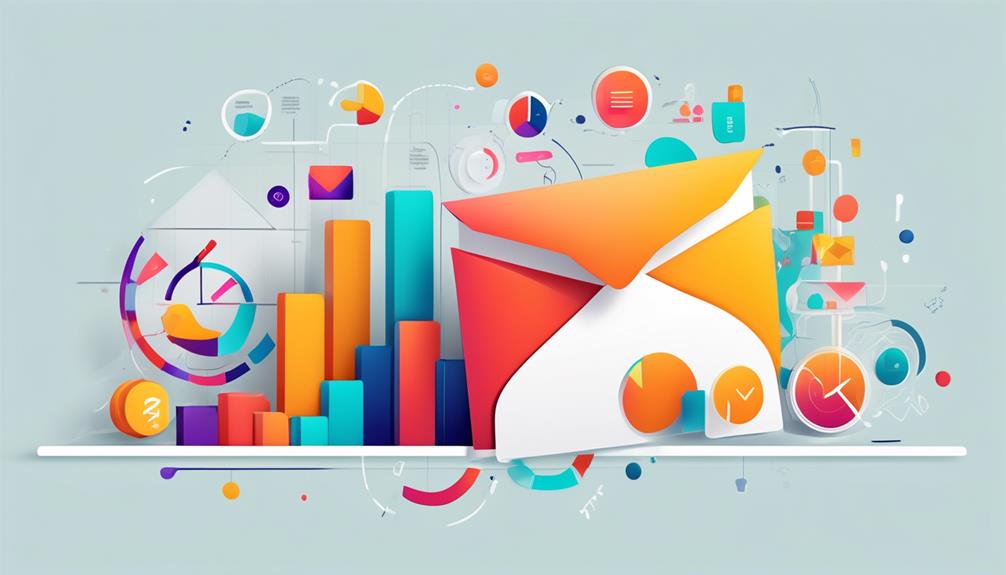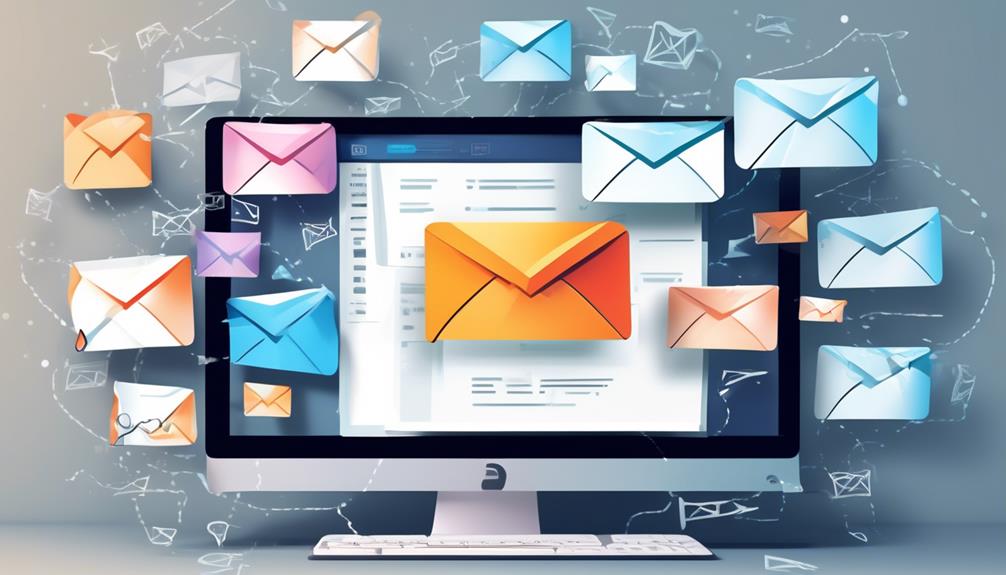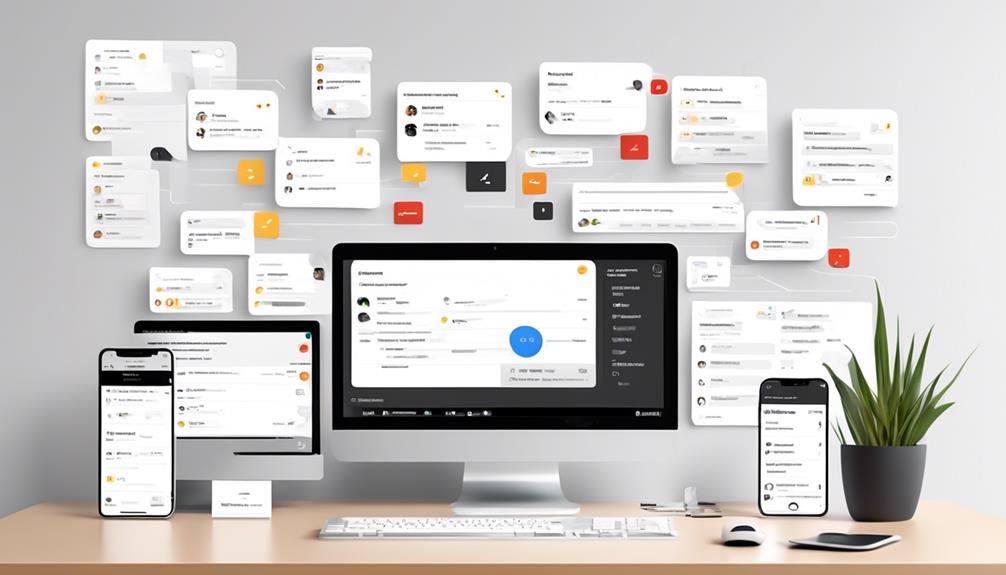Do you want to optimize your email marketing strategies and enhance your sales process?
Pipedrive Email Automation offers a range of features to help you create and track automated campaigns, personalize emails, and enhance your overall customer interactions.
With the ability to set up custom campaigns, monitor their success, and integrate with other tools like Slack, Pipedrive's Email Automation has become an essential tool for many businesses.
But that's just the beginning—there's so much more to explore in terms of leveraging automation for marketing and sales.
Key Takeaways
- Pipedrive Email Automation allows users to create highly targeted and automated campaigns for various triggers such as welcome emails, product introductions, feedback requests, and follow-up emails.
- Users can track the performance of their automated campaigns through campaign reports and insights, allowing them to make data-driven decisions and continuously improve their strategies.
- It is important to pay attention to email open rates, click-through rates, and subject lines to assess the effectiveness of email campaigns and optimize them for better engagement.
- Pipedrive Email Automation integrates with CRM and other automation tools, streamlining sales processes, improving efficiency, and enhancing productivity and collaboration among team members.
Getting Started With Pipedrive Email Automation
To kickstart your journey into Pipedrive's email automation, explore the intuitive process of creating automated campaigns and selecting triggers from a variety of available templates. Pipedrive offers a seamless experience for setting up email automation campaigns. By creating a new automation and utilizing the diverse range of templates, we can easily tailor our campaigns to suit specific triggers such as welcome emails, product introductions, feedback requests, thank you messages, and follow-up emails. This level of customization ensures that our communication with clients isn't only automated but also highly targeted and effective.
As we delve into the world of Pipedrive's email automation, it's essential to understand the power of this marketing automation tool. With Pipedrive, we've the capability to streamline sales workflows, personalize email campaigns, schedule sales workflow steps, and receive Slack notifications, all of which contribute to faster processes, rapid growth, improved customer relationships, and increased sales efficiency. By harnessing the potential of Pipedrive's automation features, we can elevate our marketing strategies and achieve unparalleled success in our campaigns.
Setting Up Automated Campaigns

We can create a welcome email for new contacts subscribing to our email list in Pipedrive's email automation platform. This allows us to engage with our audience right from the start and set the stage for further communication.
To effectively set up automated campaigns, we can use the WYSIWYG editor to craft the perfect campaign automation, ensuring that our emails are visually appealing and effectively convey our message. It's important to check campaign reports regularly to ensure consistent customer engagement, allowing us to make data-driven decisions to optimize our campaigns.
Additionally, accessing Campaigns Insights in Pipedrive's Insights tab provides valuable analytics that can help us understand the effectiveness of our automated campaigns, allowing for continuous improvement.
Tracking Campaign Engagement
Now, let's talk about the important aspect of tracking campaign engagement.
We'll cover email open rates, click-through rates, and engagement metrics tracking.
Email Open Rates
Tracking email open rates provides valuable insights into recipient engagement with our campaigns, allowing us to assess the effectiveness of our strategies and make informed optimizations for better results. Understanding the nuances of email open rates is crucial for mastering email automation and marketing.
Here are some key points to consider:
- Subject Line Impact: Crafting compelling subject lines can significantly influence open rates.
- Sender Name: The credibility and familiarity of the sender can impact open rates.
- Email Content: Relevant and personalized content often leads to higher open rates.
- Timing: Sending emails at optimal times based on recipient behavior can positively affect open rates.
Click-Through Rates
After analyzing email open rates, understanding click-through rates (CTR) becomes essential for gauging recipient engagement and assessing the impact of our email content and campaign strategies.
CTR measures the percentage of recipients who click on a link in an email, indicating engagement with the campaign. Tracking CTR is crucial for assessing the effectiveness of our email content and call-to-action, providing insights into recipient interest and engagement.
Higher CTRs usually indicate more compelling content and better-targeted campaigns, leading to increased conversion rates. A/B testing different elements in our emails, such as subject lines, visuals, and placement of links, can help optimize CTRs.
Furthermore, monitoring CTR trends over time can help identify shifts in recipient behavior and preferences, guiding adjustments to our email marketing strategy and enhancing the overall effectiveness of our email campaigns.
Engagement Metrics Tracking
We continually monitor the success of automated campaigns, such as welcome emails, product introductions, feedback requests, thank you messages, and follow-up emails, by tracking engagement metrics. Here's how we do it:
- Access Campaign Insights: Use Pipedrive's Insights tab to create reports and monitor email campaign performance.
- Sync Email and CRM: Pipedrive's marketing automation features allow seamless integration, tracking email metrics, and triggering emails based on sales pipeline changes.
- Automate Internal Processes: Utilize Pipedrive's Automations feature to guide deals and contacts through internal processes, making Pipedrive usage more efficient.
- Configure Automation Triggers: When creating an automation, access the feature, provide a name and description, add trigger events, and configure the trigger by selecting the trigger type and event.
With these strategies, you can effectively track engagement metrics, fine-tune email templates, and enhance lead nurturing in Pipedrive's email automation.
Leveraging Campaigns Insights

Let's explore how to leverage Campaigns Insights in Pipedrive to gain valuable insights into campaign performance metrics and effectively segment the target audience.
By utilizing these insights, we can assess the success of our automated campaigns and ensure that our customer engagement remains consistent.
This will allow us to make data-driven decisions and optimize our email automation strategies for maximum impact.
Campaign Performance Metrics
Leveraging Campaigns Insights in Pipedrive allows for a comprehensive analysis of campaign performance metrics, enabling targeted and data-driven decision-making. When it comes to Campaign Performance Metrics, Pipedrive offers valuable insights such as:
- Utilizing the Automations feature to create effective drip campaigns for targeted communication.
- Implementing lead scoring to identify and prioritize high-potential leads for personalized engagement.
- Monitoring the success of automated campaigns through detailed campaign reports for consistent customer engagement.
- Accessing Campaigns Insights in Pipedrive's Insights tab to create customized reports and share them with stakeholders.
Target Audience Segmentation
By harnessing the insights provided by Pipedrive's Campaigns feature, we can effectively segment our target audience for more personalized and impactful communication. Utilizing email automation, we can target specific groups with tailored campaigns, such as welcome emails for new contacts, product introductions for new leads, and feedback requests after cold calls.
This level of targeted communication is crucial for lead generation and nurturing, ensuring that our messages resonate at every stage of the customer journey. Pipedrive's Campaigns Insights enable us to access reports and monitor email campaign performance, allowing us to refine our segmentation strategies based on real-time data.
Utilizing Workflow Automation

Workflow automation in Pipedrive streamlines sales processes, improving efficiency and enhancing customer relationship management. Here's how to make the most of this powerful feature:
- Automated Campaigns: Craft tailored email campaigns for specific stages in the sales cycle, including welcome emails, product introductions, feedback requests, and follow-up messages.
- WYSIWYG Editor: Use the intuitive editor to create or add automation to campaigns, with the option to select from available templates for seamless execution.
- Permissions and Insights: Verify permissions in the Campaigns add-on to access Campaigns Insights in Pipedrive's Insights tab, enabling the monitoring of email campaign performance.
- Sales Workflow Support: Leverage Pipedrive's workflow automation tool to automatically send emails, assign tasks, update deal stages, and receive important event notifications, enhancing sales efficiency and customer relationship management.
Automating Sales Workflow

We've found that using automated email templates can save us a lot of time and effort in our sales workflow. It's been a game-changer for us, allowing us to streamline our follow-up process and maintain consistent customer engagement.
Plus, with the help of campaign reports and insights, we can easily evaluate the performance of our automated campaigns and make necessary adjustments for better results.
Time-Saving Email Templates
Efficiently engaging prospects and saving time in the sales workflow can be achieved through the use of automated campaigns for various types of emails, such as welcome messages, product introductions, and follow-ups.
With Pipedrive's email automation tool, creating time-saving email templates is effortless. Here's how it works:
- Diverse Email Types: Utilize automated campaigns for welcome emails, product introductions, feedback requests, and follow-up emails.
- Simple Setup: Create email campaigns, select new or existing automation, and use the WYSIWYG editor for crafting.
- Performance Monitoring: Check campaign reports and insights to ensure consistent engagement, verify permissions, and monitor performance.
- Comprehensive Overview: Access Campaigns Insights, create customized reports, set up dashboards, and display data in visual formats for a comprehensive overview.
Pipedrive's email automation streamlines the sales workflow, empowering sales reps to engage prospects effectively.
Streamlined Follow-Up Process
In implementing streamlined follow-up processes through Pipedrive's email automation, sales teams can seamlessly nurture leads and maintain consistent engagement without manual effort.
By automating sales workflow, we can set up targeted email campaigns for different stages of the sales process, ensuring that leads receive relevant and timely communication.
Pipedrive's WYSIWYG editor allows for the creation and customization of automated email campaigns, tailored to new contacts and ongoing sales activities.
Monitoring the performance of these campaigns is made easy through the Campaigns Insights feature in Pipedrive's Insights tab.
Additionally, leveraging Pipedrive's automation feature streamlines sales processes, supports sales reps, and schedules campaigns for customer interactions, enhancing the efficiency of the entire pipeline.
Integration with tools like Slack, Zapier, Asana, and Trello further facilitates team communication and task management within the deal automation process.
Personalizing Automated Emails

To enhance the effectiveness of automated email campaigns, incorporating personalized content tailored to individual recipients can significantly boost engagement and relevance.
When personalizing automated emails, we can leverage merge tags and dynamic content to insert personalized details such as names, company information, or recent interactions. This level of personalization creates a more tailored and relevant experience for recipients, increasing the likelihood of engagement.
By addressing specific needs and interests, personalized automated emails help build stronger connections with leads and prospects.
Implementing personalization in automated emails has been shown to lead to higher open rates, click-through rates, and overall campaign effectiveness.
With Pipedrive's email automation workflows, it becomes easier to incorporate personalization at scale, ensuring that each recipient receives content that resonates with them on an individual level.
- Utilize merge tags and dynamic content to insert personalized details.
- Create a more tailored and relevant experience for recipients.
- Build stronger connections with leads and prospects by addressing their specific needs and interests.
- Achieve higher open rates, click-through rates, and overall campaign effectiveness.
Scheduling Workflow Steps

Scheduling workflow steps in Pipedrive allows for precise automation of actions at preferred times or dates. This feature is essential for streamlining processes and ensuring timely follow-ups with clients. By utilizing the delay feature, we can set up actions or conditions with predefined or custom preferences. For instance, we can automate Slack notifications for real-time updates and custom alerts for team members based on specific stages in the workflow. It's worth noting that the Campaigns Insights feature is available to create reports and monitor the performance of email campaigns. Additionally, verifying permissions in the Campaigns add-on is crucial to ensure proper usage of the automation and campaign features. To better illustrate the scheduling capabilities of Pipedrive, the table below outlines the key aspects of this feature.
| Feature | Description | Example |
|---|---|---|
| Delay | Set up actions or conditions with predefined or custom preferences | Delaying a follow-up email by 2 days |
| Slack Notifications | Automate real-time updates and custom alerts for team members based on specific stages in the workflow | Notifying the sales team of a new lead |
| Campaigns Insights | Access to create reports and monitor the performance of email campaigns | Analyzing open rates and click-through rates |
| Permissions | Verify proper usage of the automation and campaign features to ensure data security and compliance with policies | Granting access to specific team members |
Integrating With Slack for Automation

By automating Slack notifications, we can ensure real-time updates on important activities within our Pipedrive account. Integrating with Slack for automation provides advanced capabilities for marketing and sales teams. Here's how to make the most of this integration:
- Notify team members about deal, contact, or activity updates with custom Slack notifications, ensuring everyone stays informed and aligned.
- Integrate with other automation tools like Zapier, Asana, and Trello to streamline your workflow, maximizing efficiency and productivity.
- Set up triggers for deal, contact, or activity updates to automatically send custom Slack notifications, reducing the need for manual monitoring and communication.
- Ensure consistent customer engagement by checking campaign reports and setting up dashboards to share with stakeholders, fostering transparency and collaboration.
Integrating Pipedrive with Slack for automation empowers teams to stay updated, collaborate seamlessly, and drive impactful results. This advanced functionality caters to the diverse needs of marketing and sales professionals, enhancing their ability to manage and optimize their processes effectively.
Exploring Marketing Automation Features

Exploring marketing automation features further empowers our teams to streamline processes and optimize workflows for enhanced productivity and collaboration. This builds upon the integration with Slack for automation.
Pipedrive's marketing automation features allow us to automate our sales workflow, support sales reps throughout the sales cycle, and schedule campaigns for customer interactions. To leverage these capabilities, we can start by setting up automated campaigns, creating new automations, or adding to existing campaigns using the WYSIWYG editor for crafting the perfect campaign automation.
The success of our automated campaigns can be measured through campaign reports to ensure consistent customer engagement. We can verify permissions in the Campaigns add-on and separate automations and Campaigns automation as separate features.
Additionally, Pipedrive's automation features enable us to auto-create deals and activities, transfer deal ownership, and create workflows for the sales team. We can also utilize Campaigns Insights in Pipedrive's Insights tab to create reports that monitor email campaign performance. We can set up dashboards and reports to share with stakeholders, choose from various filters, and display data in different visual formats for a comprehensive overview.
How Can I Use Pipedrive for Email Automation?
Pipedrive offers seamless integration for email automation flowchart diagrams, allowing users to streamline their sales processes. With Pipedrive’s intuitive interface, you can easily set up automated emails based on specific triggers, enabling personalized and timely communication with leads and customers. Streamline your workflow with Pipedrive’s email automation features.
Leveraging Pipedrive's Knowledge Base for Automations

To maximize our utilization of Pipedrive's automation features, we leverage the platform's Knowledge Base to gain insights and guidance on setting up automated campaigns and utilizing email automation effectively. Leveraging Pipedrive's Knowledge Base for automations provides us with valuable resources and support to enhance our workflow efficiency.
Here's how we make the most of it:
- Accessing in-depth resources on creating automated campaigns for different stages of the sales process, such as welcome emails and product introductions.
- Learning to set up automated campaigns through email templates, WYSIWYG editor, and campaign reports, ensuring a seamless and effective process.
- Exploring Campaigns Insights in Pipedrive's Insights tab to monitor email campaign performance and create customized reports for actionable insights.
- Gaining insights into Pipedrive's automation features, including personalized email automation and scheduled sales workflow steps, to streamline our processes and improve productivity.
Frequently Asked Questions
Can Pipedrive Send Automated Emails?
Yes, we can send automated emails using Pipedrive.
We set up campaigns, choose templates, and use the WYSIWYG editor to craft the perfect automation.
Monitoring success is easy with campaign reports and insights available in the Insights tab.
Pipedrive's automation features also include automating sales workflows, scheduling campaigns for customer interactions, and automating Slack notifications.
Our use of Pipedrive for automation has resulted in 40% faster processes and enhanced customer relationship management.
Does Pipedrive Have Email Sequencing?
Yes, Pipedrive does offer email sequencing.
It allows us to create and schedule a series of personalized emails to nurture leads and engage with customers.
This feature is a powerful tool in our sales automation arsenal, enabling us to strategically guide prospects through the sales funnel and build meaningful relationships.
We've seen a significant increase in response rates and conversions since implementing email sequencing in our sales process.
Does Pipedrive Do Email Campaigns?
Yes, Pipedrive does offer email campaigns. Users can set up and customize automated campaigns for various purposes, like welcome emails, product introductions, feedback requests, thank you messages, and follow-ups.
The success of these campaigns can be monitored through campaign reports and insights.
Additionally, Pipedrive's automation features extend beyond email campaigns, supporting sales reps and automating Slack notifications.
Can Pipedrive Send Mass Emails?
Yes, Pipedrive can send mass emails. It streamlines the process and enhances team productivity by automating repetitive tasks.
However, for mass email campaigns, Pipedrive recommends using the group emailing feature or the Campaigns by Pipedrive add-on, which provides additional functionalities. This approach ensures efficient communication while leveraging the platform's automation capabilities.
For more details, the Pipedrive Knowledge Base offers helpful articles and support for mastering this feature.
Conclusion
In conclusion, Pipedrive Email Automation is the drumbeat to our business growth, keeping our processes in tune and our interactions harmonious.
With custom campaigns, insightful reports, and seamless integrations, we've hit all the right notes.
Leveraging the power of automation has transformed our workflow into a symphony of efficiency and effectiveness.
Pipedrive's Email Automation is the conductor of our success, orchestrating seamless communication and propelling us towards rapid growth.









